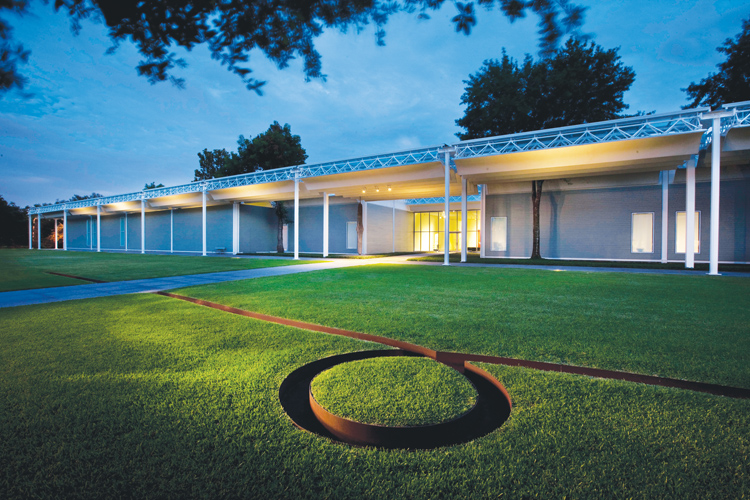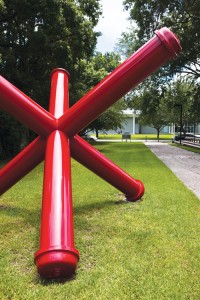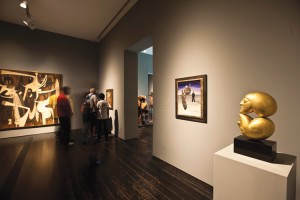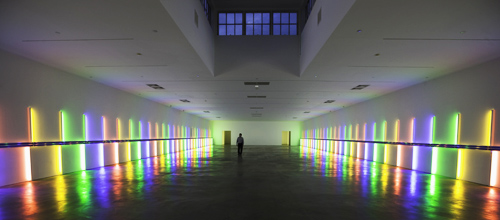
The Most Famous ‘Neighborhood’ Museum Turns 25

Montrose’s Menil Collection reaches maturity
by Rich Arenschieldt
Longtime Houstonians living here in the mid-1980s remember the changes—all the little gray “artist” bungalows on a large plot of land bounded by Mandell and Yupon were somewhat suddenly relocated. Something was happening in the neighborhood, and it was significant.
Twenty-five years later, the realization of a mid-century dream by Schlumberger heiress and longtime artistic doyenne Dominique de Menil and her husband, John, has made Houston a must-see destination for the world’s art lovers. The Menil Collection opened on June 4, 1987, with festivities attended by an international gallery of notables.

John and Dominique met at a ball in Versailles in 1930 and were married the following year. They fled France during World War II and settled in Houston, where John would direct the worldwide operation of his father-in-law’s oil company, Schlumberger.
Fifteen years later, John de Menil returned from visiting Paris with a small watercolor by Post-Impressionist master Paul Cézanne. That $300 purchase is credited as the first work in what would eventually become the Menil Collection. Though John de Menil predeceased his wife by 25 years, they had both dreamed and discussed creating a home for what would become a massive and eclectic collection.
Because the works housed in the Menil Collection were theirs, a deep sense of “personal-ness” and intimacy guided decisions about the establishment of the Menil Foundation and creation of the subsequent building that showcases the collection.
“Visiting the Menil’s River Oaks-area mid-century home [designed by noted architect Philip Johnson], you can sense how they wanted their museum building to be,” says Vance Muse, the Menil’s communications director. Owned by the Menil Foundation and lovingly restored, this “International Style” home is low-slung and elongated, elegant in its simplicity, form, and function. “From its first incarnation, the [museum] building always had a sense of relationship with its surroundings and with the neighborhood where it is cited. Mrs. de Menil knew that she wanted the building to relate to those around it. Her chosen architect, Renzo Piano, knew how to bring wishes into reality.”
One of the core values the Menil Foundation still espouses is to “preserve the sprit and character of the campus environment and neighborhood setting.” Mrs. Menil told Piano, “I want the museum to be small on the outside, but as big as possible on the inside.”
While many other museums have edifices that glorify their reputations, the Menil structure serves to amplify the primacy of the art it houses. Surveys of architectural experts routinely place Piano’s cedar-clad creation as one of the top ten buildings in the world.
 Architect Piano valued physical structure and natural light as equals in importance. Photos in the Menil archives show him and Mrs. de Menil working with models and lighting measurements. The result is a semi-spiritual environment where natural illumination prevails. Critics universally praised the entire project; upon opening, the Los Angeles Times wrote, “Its fusion of contemplative galleries and natural light has put the Menil on many an art lover’s short list of cherished places….” The normally staid Financial Times of London called the Menil “…rare and attractive—important and eclectic. One of the biggest surprises in a surprisingly culturally driven city.”
Architect Piano valued physical structure and natural light as equals in importance. Photos in the Menil archives show him and Mrs. de Menil working with models and lighting measurements. The result is a semi-spiritual environment where natural illumination prevails. Critics universally praised the entire project; upon opening, the Los Angeles Times wrote, “Its fusion of contemplative galleries and natural light has put the Menil on many an art lover’s short list of cherished places….” The normally staid Financial Times of London called the Menil “…rare and attractive—important and eclectic. One of the biggest surprises in a surprisingly culturally driven city.”
A number of special events celebrate the 25th anniversary. There is the requisite gala in November, special exhibits, and a community-wide celebration. On Saturday afternoon, September 22, on the museum’s front lawn, the Menil hosts a neighborhood block party with music, cake, and ice cream. Inside the Menil there will be a special showing of archival items from Dominique de Menil’s personal papers. These items, some of which have been stored in the Menil home for decades, have been gathered from various sources. These are not grand masterworks, but rather the intimate correspondence between many of the 20th century’s most important artists and Mrs. de Menil—postcards, letters, and simple hand-drawn art. A 1957 note from surrealist painter Victor Brauner to de Menil evokes a wonderful intimacy between the two—“…I feel a festive joy that these pieces of mine are arriving in your home, where I feel the love and insightful joy with which they are surrounded.”
 Dominique de Menil remained a quiet and thoughtful force in the cultural and artistic life of Houston for decades. Her legacy includes numerous contributions to local artistic institutions, the foundation’s Cy Twombly Gallery, and two of Houston’s spiritual landmarks, the former Byzantine Fresco Chapel and the interfaith Rothko Chapel. The foundation that survived her will, in the words of its founders, “continue[s] to be unconventional and farsighted…. Inventiveness, however, should be blended with continuity, which is essential for lasting creation.”
Dominique de Menil remained a quiet and thoughtful force in the cultural and artistic life of Houston for decades. Her legacy includes numerous contributions to local artistic institutions, the foundation’s Cy Twombly Gallery, and two of Houston’s spiritual landmarks, the former Byzantine Fresco Chapel and the interfaith Rothko Chapel. The foundation that survived her will, in the words of its founders, “continue[s] to be unconventional and farsighted…. Inventiveness, however, should be blended with continuity, which is essential for lasting creation.”
The Menil’s master plan calls for the completion of some original elements not completed when the museum opened in 1987. The site plan includes an expanded Menil Bookshop, visitors’ café, and additional buildings for public usage and social functions. As expected, these elements will take shape with careful attention and in appropriate scale to the surrounding “Menil neighborhood.”
The current exhibition, Silence—Modern artists invoking soundlessness into shape, space and consciousness, is on view until October 21. For more information, visit menil.org.
Rich Arenschieldt is a frequent contributor to OutSmart magazine.












Comments